And again, some general educational material. This time we will talk about base stations. Let's look at various technical aspects of their placement, design and range, and also look inside the antenna unit itself.
Base stations. General information
This is what the antennas look like cellular communications installed on the roofs of buildings. These antennas are an element of a base station (BS), and specifically a device for receiving and transmitting a radio signal from one subscriber to another, and then through an amplifier to the base station controller and other devices. Being the most visible part of the BS, they are installed on antenna masts, roofs of residential and industrial buildings, and even chimneys. Today you can find more exotic options for their installation; in Russia they are already installed on lighting poles, and in Egypt they are even “disguised” as palm trees.

The connection of the base station to the telecom operator’s network can be done via radio relay communication, so next to the “rectangular” antennas of the BS units you can see a radio relay dish:
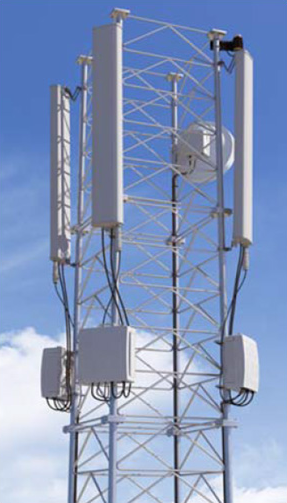
With the transition to more modern standards of the fourth and fifth generations, to meet their requirements, stations will need to be connected exclusively via fiber optics. In modern BS designs, optical fiber becomes an integral medium for transmitting information even between nodes and blocks of the BS itself. For example, the figure below shows the design of a modern base station, where fiber optic cable is used to transmit data from the RRU (remote controlled units) antenna to the base station itself (shown in orange).
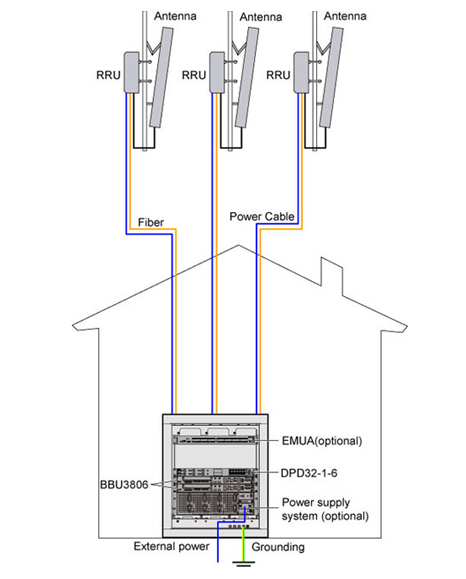
The base station equipment is located in non-residential premises of the building, or installed in specialized containers (attached to walls or poles), because modern equipment is quite compact and can easily fit into system unit server computer. Often the radio module is installed next to the antenna unit, this helps reduce losses and dissipation of power transmitted to the antenna. This is what the three installed radio modules of the Flexi Multiradio base station equipment look like, mounted directly on the mast:

Base station service area
To begin with, it should be noted that there are Various types base stations: macro, micro, pico and femtocells. Let's start small. And, in short, a femtocell is not a base station. It is rather an Access Point. This equipment is initially aimed at a home or office user and the owner of such equipment is a private or legal entity. a person other than the operator. The main difference between such equipment is that it has a fully automatic configuration, from assessing radio parameters to connecting to the operator’s network. Femtocell has the dimensions of a home router:
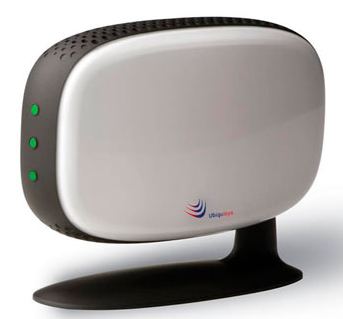
A picocell is a low-power BS owned by an operator and using IP/Ethernet as a transport network. Usually installed in places where there is a possible local concentration of users. The device is comparable in size to a small laptop:

A microcell is an approximate version of the implementation of a base station in a compact form, very common in operator networks. It is distinguished from a “large” base station by a reduced capacity supported by the subscriber and lower radiating power. Weight, as a rule, is up to 50 kg and radio coverage radius is up to 5 km. This solution is used where it is not needed high capacities and network power, or is it not possible to install a large station:

And finally, a macro cell is a standard base station on the basis of which mobile networks. It is characterized by powers of the order of 50 W and a coverage radius of up to 100 km (in the limit). The weight of the stand can reach 300 kg.
The coverage area of each BS depends on the height of the antenna section, the terrain and the number of obstacles on the way to the subscriber. When installing a base station, the coverage radius is not always at the forefront. As the subscriber base grows, the maximum may not be enough bandwidth BS, in this case the message “network busy” appears on the phone screen. Then, over time, the operator in this area can deliberately reduce the range of the base station and install several additional stations in areas of greatest load.
When you need to increase network capacity and reduce the load on individual base stations, then microcells come to the rescue. In a megacity, the radio coverage area of one microcell can be only 500 meters.
In a city environment, oddly enough, there are places where the operator needs to locally connect an area with a lot of traffic (metro station areas, large central streets, etc.). In this case, low-power microcells and picocells are used, the antenna units of which can be placed on low buildings and on street lighting poles. When the question arises of organizing high-quality radio coverage inside closed buildings (shopping and business centers, hypermarkets, etc.), then picocell base stations come to the rescue.
Outside cities, the operating range of individual base stations comes to the fore, so the installation of each base station away from the city is becoming an increasingly expensive enterprise due to the need to build power lines, roads and towers in difficult climatic and technological conditions. To increase the coverage area, it is advisable to install the BS on higher masts, use directional sector emitters, and lower frequencies that are less susceptible to attenuation.
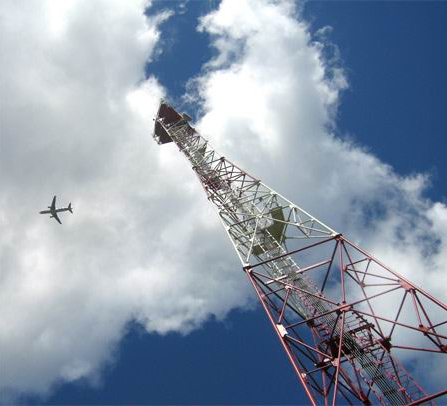
So, for example, in the 1800 MHz band, the range of the BS does not exceed 6-7 kilometers, and in the case of using the 900 MHz band, the coverage area can reach 32 kilometers, all other things being equal.
Base station antennas. Let's take a look inside
In cellular communications, sector panel antennas are most often used, which have a radiation pattern with a width of 120, 90, 60 and 30 degrees. Accordingly, to organize communication in all directions (from 0 to 360), 3 (pattern width 120 degrees) or 6 (pattern width 60 degrees) antenna units may be required. An example of organizing uniform coverage in all directions is shown in the figure below:

And below is a view of typical radiation patterns on a logarithmic scale.

Most base station antennas are broadband, allowing operation in one, two or three frequency bands. Starting with UMTS networks, unlike GSM, base station antennas are able to change the radio coverage area depending on the load on the network. One of the most effective methods of controlling radiated power is to control the angle of the antenna, in this way the irradiation area of the radiation pattern changes.
Antennas can have a fixed angle of inclination, or can be remotely adjusted using a special software, located in the BS control unit, and built-in phase shifters. There are also solutions that allow you to change the service area, from common system data network management. In this way, it is possible to regulate the service area of the entire sector of the base station.
Base station antennas use both mechanical and electrical pattern control. Mechanical control easier to implement, but often leads to distortion of the shape of the radiation pattern due to the influence of structural parts. Most BS antennas have an electrical tilt angle adjustment system.
A modern antenna unit is a group of radiating elements of an antenna array. The distance between the array elements is selected in such a way as to obtain the lowest level of side lobes of the radiation pattern. The most common panel antenna lengths are from 0.7 to 2.6 meters (for multi-band antenna panels). The gain varies from 12 to 20 dBi.
The figure below (left) shows the design of one of the most common (but already outdated) antenna panels.

Here, the antenna panel emitters are half-wave symmetrical electric vibrators above the conductive screen, located at an angle of 45 degrees. This design allows you to create a diagram with a main lobe width of 65 or 90 degrees. In this design, dual- and even tri-band antenna units are produced (though quite large). For example, a tri-band antenna panel of this design (900, 1800, 2100 MHz) differs from a single-band one, being approximately twice as large in size and weight, which, of course, makes it difficult to maintain.
An alternative manufacturing technology for such antennas involves making strip antenna radiators (square-shaped metal plates), in the figure above on the right.
And here is another option, when half-wave slot magnetic vibrators are used as a radiator. The power line, slots and screen are made on one printed circuit board with double-sided foil fiberglass:

Taking into account the modern realities of the development of wireless technologies, base stations must support 2G, 3G and LTE networks. And if the control units of base stations of networks of different generations can be placed in one switching cabinet without increasing the overall size, then significant difficulties arise with the antenna part.
For example, in multi-band antenna panels the number of coaxial connecting lines reaches 100 meters! Such a significant cable length and the number of soldered connections inevitably leads to line losses and a decrease in gain:

In order to reduce electrical losses and reduce solder points, microstrip lines are often made; this makes it possible to create dipoles and the power supply system for the entire antenna using a single printed technology. This technology easy to manufacture and ensures high repeatability of antenna characteristics during serial production.
Multiband antennas
With the development of communication networks of the third and fourth generation modernization of the antenna part of both base stations and cell phones is required. Antennas must operate in new additional bands exceeding 2.2 GHz. Moreover, work in two and even three ranges must be carried out simultaneously. As a result, the antenna part includes rather complex electromechanical circuits, which must ensure proper functioning in difficult climatic conditions.
As an example, consider the design of the emitters of a dual-band antenna of a Powerwave cellular communication base station operating in the ranges 824-960 MHz and 1710-2170 MHz. Her appearance shown in the picture below:

This dual-band irradiator consists of two metal plates. The one that bigger size operates in the lower 900 MHz range, above it there is a plate with a smaller slot emitter. Both antennas are excited by slot emitters and thus have a single power line.
If dipole antennas are used as emitters, then it is necessary to install a separate dipole for each wave range. Individual dipoles must have their own power line, which, of course, reduces the overall reliability of the system and increases power consumption. An example of such a design is the Kathrein antenna for the same frequency range as discussed above:
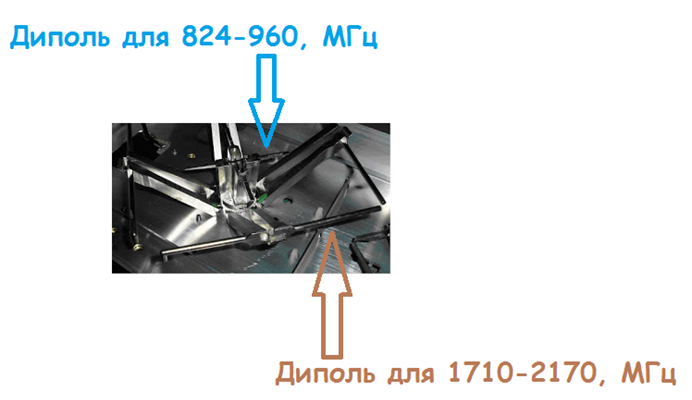
Thus, the dipoles for the lower frequency range are, as it were, inside the dipoles of the upper range.
To implement three- (or more) band operating modes, printed multilayer antennas have the greatest technological efficiency. In such antennas, each new layer operates in a rather narrow frequency range. This “multi-story” design is made of printed antennas with individual emitters, each antenna is tuned to individual frequencies in the operating range. The design is illustrated in the figure below:
As in any other multi-element antennas, in this design there is interaction between elements operating in different frequency ranges. Of course, this interaction affects the directivity and matching of the antennas, but this interaction can be eliminated by methods used in phased array antennas (phased array antennas). For example, one of the most effective methods is to change the design parameters of the elements by displacing the exciting device, as well as changing the dimensions of the feed itself and the thickness of the dielectric separating layer.
The important point is that all modern wireless technologies broadband, and the operating frequency bandwidth is at least 0.2 GHz. Antennas based on complementary structures, a typical example of which are “bow-tie” antennas, have a wide operating frequency band. Coordination of such an antenna with the transmission line is carried out by selecting the excitation point and optimizing its configuration. To expand the operating frequency band, by agreement, the “butterfly” is supplemented with a capacitive input impedance.
Modeling and calculation of such antennas are carried out in specialized CAD software packages. Modern programs allow you to simulate an antenna in a translucent housing in the presence of the influence of various structural elements of the antenna system and thereby allow you to perform a fairly accurate engineering analysis.
The design of a multi-band antenna is carried out in stages. First, a microstrip printed antenna with a wide bandwidth is calculated and designed for each operating frequency range separately. Next, printed antennas of different ranges are combined (overlapping each other) and their joint operation is examined, eliminating, if possible, the causes of mutual influence.

A broadband butterfly antenna can be successfully used as the basis for a tri-band printed antenna. The figure below shows four different configuration options.
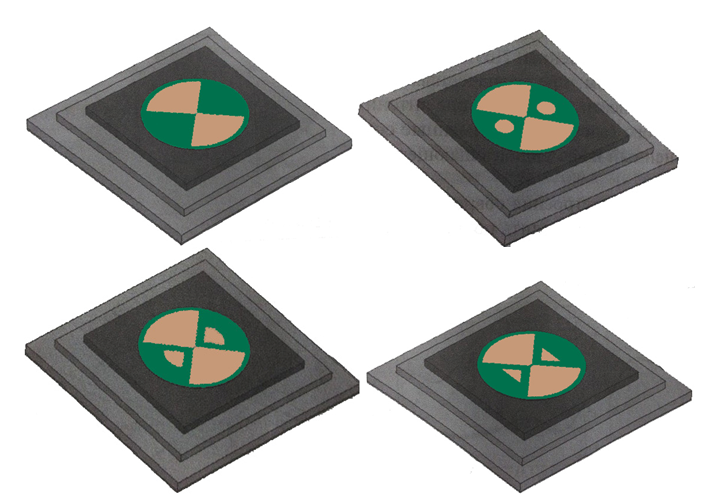
The above antenna designs differ in the shape of the reactive element, which is used to expand the operating frequency band by agreement. Each layer of such a tri-band antenna is a microstrip emitter of given geometric dimensions. The lower the frequencies, the larger the relative size of such an emitter. Each layer printed circuit board separated from another by a dielectric. The above design can operate in the GSM 1900 band (1850-1990 MHz) - accepts the bottom layer; WiMAX (2.5 - 2.69 GHz) - receives the middle layer; WiMAX (3.3 - 3.5 GHz) - receives the upper layer. This design of the antenna system will make it possible to receive and transmit radio signals without the use of additional active equipment, thereby not increasing the overall dimensions of the antenna unit.
And in conclusion, a little about the dangers of BS
Sometimes, base stations of cellular operators are installed directly on the roofs of residential buildings, which actually demoralizes some of their inhabitants. Apartment owners stop having cats, and gray hair begins to appear faster on grandma's head. Meanwhile, the residents of this house receive almost no electromagnetic field from the installed base station, because the base station does not radiate “downward.” And, by the way, the norms of SanPiN for electromagnetic radiation in the Russian Federation is an order of magnitude lower than in the “developed” countries of the West, and therefore, within the city, base stations never operate at full capacity. Thus, there is no harm from BS, unless you sunbathe on the roof a couple of meters from them. Often, there are a dozen access points installed in residents’ apartments, as well as microwaves And Cell Phones(pressed to your head) have a much greater impact on you than a base station installed 100 meters outside the building.
Many people are interested in the question of whether a cell tower near their home will be harmful to health or not. To understand this issue, you should study the specifics of the device’s operation, and understand exactly at what distance the radioactive influence, if any, will emanate.
First of all, it is important to note that these are the base stations that control the cellular (or mobile) telephone communication. The term "cell" includes all cell phone towers, antenna masts, and other forms of base station.
Each tower serves a small area around it, known as a cell. Service providers are trying to improve their coverage and therefore serve more users. Therefore, they need to continue to build these same towers.
Increasing cell phone traffic is driving cell density increases. When a cell becomes too busy, common solution is to divide it into smaller cells that require more cell towers.
Cell phone towers can be shaped like a mast or tower, but they can also be camouflaged, making them difficult to distinguish visually.
Let's say that sometimes you can see camouflaged "trees", or structures on top of buildings that look like elongated loudspeaker columns.
What is the harm of radiation to humans?
LOSE TWO SIZES IN A MONTH!
The formula for losing weight is simple - burn more calories than you take into your body. But how can this be achieved in practice? Depleting yourself with complex and often dangerous diets is very risky. Spending a lot of money and time on the gym is not something everyone can afford. Kartunkova named the mistake of all those who are losing weight: “Girls, lose weight simply, here is the recipe: before breakfast...” FOR 1 RUBLE.....
Where a base station is installed on top of a building in which people live or work, they are usually completely unaware that such an object is nearby. People are not aware that there is a high level of radio radiation around.
The cell phone industry continues to claim that cell phone towers do not pose a health hazard, but this is not entirely true. Almost all scientists in the field would disagree that cell towers are safe, except those used in industry.
There is compelling evidence that electromagnetic radiation from cell phones is detrimental to human (and animal) health.
Example. A study on the effects of a cage tower on a dairy cattle herd was conducted by the Bavarian state government in Germany and published in 1998. The erected cell towers have caused adverse effects on human health, leading to a noticeable decrease in milk yield. Relocating livestock restored milk yield. Moving them back to their original pasture again caused the problem identified earlier to develop.
In 2007, a study was conducted regarding the harm to human health that comes from cell phone towers. The scientists measured blood levels of seratonin and melatonin (important hormones involved in metabolism that directly influence mood, sleep regulation, and immune system function) both before and five months after activating the new equipment up close. Twenty-five participants lived within 300 meters of the site. Significant adverse changes occurred in both hormones in almost all participants.
Based on this, it can be argued that this equipment poses significant harm to human health.
Can cell towers cause cancer?
The study, conducted by doctors from the German city of Naila, monitored 1,000 residents living in an area near two cell phone stations for 10 years.
During the last 5 years of the study, it was found that those living within 400 meters of any tower were three times more likely to have recently been diagnosed with cancer than those living further away.
According to scientists, the occurrence of cancer is directly related to the effects of radio radiation on the body.
The list of the most common ailments included:
- breast cancer (this diagnosis topped the list);
- prostate cancer;
- pancreatic neoplasms;
- intestinal diseases;
- skin melanomas;
- lung and blood cancer.
Unfortunately, few studies have specifically focused on the risk of cancer from cell phones. This lack of research is concerning in itself, especially since the anecdotal evidence is plentiful.
In a case known as "Towers of Doom", it was said that two sets of equipment were installed in a five-story apartment building in London to support cellular communications (in 1994). In subsequent years, residents complained of many health problems. Seven of them were diagnosed with cancer. The infection rate for residents on the top floor (closest to the tower) was 10 times higher than the national average.
The World Health Organization has recognized that radiofrequency radiation can cause cancer.
But it should be remembered that harm from such equipment does not occur immediately. Cancer occurs only when all of the body's defenses and repair mechanisms have been exhausted and overloaded.
Over these years, the human body will be exposed to radiation every day.
Symptoms of health problems
For some people, short-term effects from radiation exposure to cells may include headaches, sleep disturbances, poor memory, mental agitation, confusion, anxiety, depression, loss of appetite and lethargy.
A small group of doctors from Bamberg, Germany, conducted their own study in 2005. They found increasing rates of both minor and serious health problems in patients exposed to more high levels radiation.
These health problems included tumors, diabetes, heart rhythm disorders, inflammatory conditions, joint and limb pain, frequent infections, headaches, sleep disorders, depression and memory problems.
The American Academy of Environmental Medicine reports that research shows "significant harmful biological effects occur with non-thermal radiofrequency exposure," and these effects may include genetic damage, reproductive defects, cancer, neurological degeneration and nervous system dysfunction, immune system dysfunction, cognitive effects.
This list of negative changes may be supplemented by other symptoms and diagnoses.
Cell radio emission levels
Legal limit for radiation levels from cell tower- 1000 μW per square centimeter.
Other countries have limits of up to 1 microwatt per square centimeter. Switzerland, Italy, China and others cope well with a limit of 10 microwatts per square centimeter. Why is there such a huge difference? It appears that some governments are more concerned about EMF security than others. The truth is that no one knows what level of radiation from a tower will be safe in the long term.
It appears that the current EMF restrictions have been influenced by economic and political motives rather than by safety and health considerations.
Radiation levels from one area of a cell vary depending on use at different times of day. The radiation from a tower with one cell is different in different directions. Radiation is affected by the quality of the ground and shielding and reflections from buildings. And finally, even the choice of building and finishing materials for a home affects its resistance to radio frequency radiation.
If the nearest cell site is more than 400 meters away, it probably does not cause harm, although high-risk groups and electrolyte-sensitive people should be more careful.
To minimize the harmfulness that comes from the stations, you should acquire a radio frequency gauss meter. It is designed to measure electromagnetic radiation in the cell phone frequency range (microwave).
One thing to remember is that in every home there are rooms where EMF radiation is higher or lower, just as some parts of the house may be brighter or darker due to window placement.
High levels of EMF are just one of the risk factors for the body. If the ability to reduce EMF is limited, you can help the body in other ways to minimize exposure to other types of pollution in the air, water and food.
Good nutrition, exercise and good sleep will help the body repair radiation damage.
The article is addressed to the heads of operating organizations of residential and administrative buildings, schools, colleges, universities, hospitals, clinics, boarding schools, shopping and entertainment centers, structures and metro lines, business centers, underground passages, tunnels, sports buildings and facilities, swimming pools and water parks, multi-storey garages, car parks that are considering the possibility of placing cellular base stations (on a commercial or non-commercial basis) or already have such “electromagnetic” tenants.
“The subscriber’s device is outside the coverage area of the network...” Probably everyone has heard these words on a mobile phone handset, but who has thought about what this actually means? What network is the person outside the coverage area of? How secure are communication base stations on city buildings?
Let's try to figure it out. The main components of a cellular network are subscriber stations ( Cell phones, USB modems) and base stations (sometimes repeater stations or repeaters). The cell phone “listens” to the airwaves, finds the signal from the base station and sends it its identification code. The mobile phone and the base station are constantly in radio contact. If the phone leaves the coverage area of one base station, it establishes communication with another. Let's talk about the influence of landline, that is, cellular base stations, especially since they are very often placed on city buildings, including those where people live or work throughout the day.
Expanding the network - increasing the intensity of the electromagnetic field?
The total radio coverage area is divided into cells (cells). A cell is determined by the radio coverage area of an individual base station. The cells partially overlap and form a common network. The network consists of transceivers and switching equipment. This is what determines the location mobile subscriber and ensures continuity of communication when moving from one cell to another.
Commercial use of cellular communications in Russia began in 1991. The first mobile phones were heavy, bulky and limited in functionality, the network was leaky, and handset tariffs were very expensive. Almost 20 years have passed, and people, despite the economic crisis, will never refuse services mobile communications. Tariffs and services mobile operators today it is much wider and more accessible in technological and economic terms, and cell phones, which have become not only cheaper and more functional, are a common attribute of our lives.
Moscow, as the largest city and capital of the country, is the undisputed leader in the consumption of cellular communication services in Russia. To meet the growing needs of subscribers, operators are developing and modernizing their networks. One of the main tasks when developing a network and modernizing base stations is not to harm the health of the population. At the same time, the main factor that determines the coverage of a base station and, at the same time, its adverse impact on health is the intensity of the electromagnetic field.
Base stations and sanitary protection zones
The base station consists of a hardware room that houses radio equipment, a feeder path and antennas. The sources of the electromagnetic field at the base station are radio transmitting antennas. Work on the examination of design materials for the placement and modernization of base stations is carried out in accordance with SanPiN 2.1.8/2.2.4.1190-03 “Hygienic requirements for the placement and operation of land mobile radio communications”. In this case, the main attention is paid to the calculations of the sanitary protection zone and the development restriction zone. A mandatory requirement is to carry out summary calculations taking into account the existing radio transmitting equipment of other telecom operators.
Here it is necessary to clarify that the sanitary protection zone from base station antennas is determined by the maximum energy flux density for the population (10 μW/cm2) at a height of 2 m from ground level, and the development restriction zone is determined at a height of more than 2 m from ground level. Base station antennas are installed on free-standing towers, masts, as well as on existing buildings at a certain height. The main thing is to place the antenna so that neighboring buildings and areas free from buildings do not fall into the danger zone. The dimensions of such zones and development restriction zones are determined during calculations using approved methods.
How are danger zones calculated?
Dangerous zones are calculated according to the current MRL for the population. Calculations are carried out in both horizontal and vertical planes. Why? Because when calculating dangerous areas, the width of the antenna radiation pattern must be taken into account. This characteristic is provided by the antenna designer or manufacturer. Panel antennas used at base stations have a fairly pronounced width in the horizontal plane and a narrow width in the vertical plane. The shape of the danger zone can be compared to a flat pie in the direction of the antenna radiation. Behind the antenna, the intensity of the electromagnetic field drops sharply.
Without knowledge of such parameters as frequency range, power supplied to the antenna (determined based on the type of equipment, number and power of transmitters, their connection diagram, characteristics of the feeder path, etc.), type of antenna and its characteristics, installation height, azimuth and It is impossible to calculate the size of dangerous zones from the radiation elevation angle. Approximately, as they say, by eye, all of the named parameters cannot be determined.
The base station is designed in such a way that existing buildings are under the zones of dangerous radiation and do not fall into it, that is, they remain outside the station's restrictions. Taking into account the fact that base stations in populated areas are placed on existing buildings and structures (including pipes, towers, lighting masts, etc.), the possibilities for organizing a sanitary protection zone are limited. During the examination, special attention is paid to ensuring that stations being designed or put into operation at a height of 2 m from ground level do not create increased levels of the electromagnetic field for the population. There is not a single base station in the capital with a sanitary protection zone.
Where can base stations be built?
Residents very often ask at what distance from residential buildings the construction of base stations is allowed. Sanitary rules do not establish such a distance, and stations are allowed to be installed in residential and public buildings, subject to compliance with the maximum permissible limits for electromagnetic radiation in the premises of these buildings and in the adjacent territory. Thus, the very fact of placing base stations in residential buildings, schools, hospitals, boarding homes, administrative and other buildings does not contradict the current sanitary and epidemiological rules and regulations.
It should be noted that, despite the use of low power transmitters, cellular base stations are increasingly becoming potentially significant sources of electromagnetic fields in the environment. This is due to the following:
. antennas are installed at a low height from the surface of the earth;
. they have a fairly pronounced angle of inclination of the radiation axis;
. existing buildings change (as a result of reconstruction of buildings, new construction near existing base stations).
In addition, it is practiced to place internal antennas (indoor station or indoor sector of the station) in shopping and entertainment centers, buildings and on metro lines, in business centers, administrative buildings, underground passages, tunnels, gyms and buildings, high-rise residential buildings, garages, vehicle parking, etc. At the same time, the subscriber gets the opportunity to use communication services wherever he is. The task of telecom operators, bodies and institutions of Rospotrebnadzor in this case is to ensure the safe electromagnetic impact of outdoor antennas on the population.
Control measurements
The compliance of the electromagnetic field with the installed remote control panels in the premises of buildings and on the territory is determined during control measurements. Such measurements are carried out upon completion of construction or during the modernization of the station, when it can already operate at full radiation. If there are no changes in the conditions and mode of operation of the stations, measurements are carried out at least once every three years.
If a discrepancy between the electromagnetic field levels of the remote control is detected, the station owner must take measures to develop and implement the necessary measures. The generally accepted and most acceptable protective measure is the rational placement of stations, which includes the type of antennas chosen, their installation, and the direction of radiation. Reducing transmitter power is a necessary measure when other solutions are impossible. Among building materials, metal, especially copper, has the best shielding properties. Good screen Reinforced concrete structures and brick walls can also be considered.
Often, zones with increased levels of electromagnetic fields for the population are determined on the roofs of buildings near the station antennas. In such situations, work on roof areas near antennas is allowed if the corresponding station transmitters are turned off. The operator informs the lessor of the presence of dangerous areas and marks them with warning signs.
Based on the results of the sanitary and epidemiological examination of the calculation materials, the station owner is issued a sanitary and epidemiological certificate for the placement of the station, and based on the results of control measurements, a sanitary and epidemiological certificate for its operation is issued.
The article uses materials from the article "Placement of cellular base stations on the roofs of residential, children's and medical buildings, in sports and shopping and entertainment centers and tunnels"" of the magazine "SES" No. 9 (97), 2010
